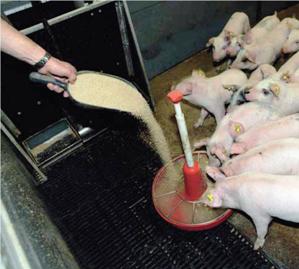Counteracting zearalenone contamination in pig feeds

Are mycotoxins really present in animal feeds? Are swine affected by them? To keep it short and simple: Yes! Mycotoxins indeed exist in cereals harvested worldwide and pigs are generally known to be the most sensitive species to mycotoxins, especially zearalenone.
The first notion to understand when we are talking about zearalenone (ZEA) in swine is that this animal species is the most sensitive to it due to its low glucuronidation capacity. In other words, their metabolism of xenobiotic (foreign) substances such as drugs, exogenous estrogens, amongst others, is reduced, thus making swine the most susceptible animals to zearalenone in comparison with other animal species.
Zearalenone is an estrogenic mycotoxin produced by Fusarium spp. fungi which cause plant diseases prior to harvesting. Especially alpha-zearalenone, which can be formed from zearalenone in the gastrointestinal tract as well as in the liver of the animals, is critical. Why? The affinity of alpha-zearalenone for uterine and oviduct oestrogen receptors in swine is even higher than the affinity of the parent compound. It attaches to the oestrogen receptors and is then transferred into the cell nucleus thus activating mRNA synthesis (which would normally be done by oestrogen, the female hormone).
All phases of production affected
Scientific work has been conducted for many years on the effects of zearalenone in swine at different stages. Among other factors, the effects of zearalenone depend on the reproductive status of the animals. It is well-known that especially prepubertal gilts are sensitive to zearalenone as relatively high levels of these mycotoxins can cause early puberty. Needless to say that the first heats of these “early blooming” animals are infertile as they occur without ovulation. More recently, levels as low as 235 to 358 ppb ZEA have shown to significantly reduce the intrinsic quality of oocytes.
But the effects of this toxin go beyond those in gilts. Also sows, embryos, newborn piglets and even boars are affected. Acyclic sows, smaller litters, stillbirths, higher neonatal mortality, mummification, swollen vulvas and splay legs in female piglets have been reported in several studies by the intake of this toxin. These undesirable effects have an economic impact on farm level and furthermore they go against breed improvement and impede the full expression of swine’s genetic potential.
Even with strenuous preventative efforts it is quite improbable that feedstuffs are entirely free of mycotoxins as most of the contamination occurs on the field, where external factors such as weather conditions cannot be controlled by man. However, the field of mycotoxins counteraction has experienced quite a lot of advances throughout the past few years and nowadays several solutions are available to diminish the effects of mycotoxins in animals, which, beside binding mycotoxins, also have positive influence on metabolism. Mastersorb Gold from EW Nutrition/Grasp has such a complete formulation of synergistic components:
- Mineral components like aluminosilicates, which adsorb mycotoxins by chemical bonds and form insoluble complexes, eliminate a wide variety of mycotoxins.
- Phytolytic components (mannan-oligosaccharides and ß-glucans) adsorb mycotoxins with a high molecular weight. The defence cells of the body are activated, the immune response increases.
- Herbal extracts with high contents of polyphenols support the immune system by activating the antioxidant enzyme system. By catching free radicals, the lipid peroxidation can be inhibited.
Milk thistle extract protects the liver from mycotoxins and other remaining toxins. This leads to an improvement of the hepatic metabolism and consequently optimises the adsorptions of nutrients thus increasing feed efficiency. The positive effects of Silymarin, the extract of the milk thistle, have been demonstrated in humans. In dairy cows, milk thistle extracts improve the metabolism of the liver and the performance parameters.To evaluate the effectiveness of Mastersorb Gold, a trial was conducted by LAMIC (Laboratório de Análises Micotoxicológicas da UFSM, Brasil). Three groups with six piglets, 9.5 kg of initial weight, were fed during 21 day diets as follows:
a. Control – no zearalenone, no Mastersorb Gold
b. Zearalenone: Diet contains 1500 ppb (1.5 ppm) of zearalenone
c. Zearalenone + Mastersorb: 1.5 ppm zearalenone and 0,3% Mastersorb Gold
Average vulva volume and the absolute weight of the reproductive tract were measured. As in Figure 1 is shown, Mastersorb Gold significantly reduces the vulva volume of the piglets after 21 days (p<0.01). Furthermore a positive effect of Mastersorb Gold on the weight of the reproductive tract of the animals could be demonstrated.
Conclusion
The adsorption of mycotoxins is essential, but not sufficient. You have to go further. Complete solutions against mycotoxins should include binding substances with different binding characteristics. Additional support of the metabolism helps the animal to cope with the consequences of intoxication. A combination of minerals, mannans, glucans and herbal extracts is effective in protecting the animals from mycotoxicosis and thus maximises the performance of the stocks.
The adsorption of mycotoxins is essential, but not sufficient. You have to go further. Complete solutions against mycotoxins should include binding substances with different binding characteristics. Additional support of the metabolism helps the animal to cope with the consequences of intoxication. A combination of minerals, mannans, glucans and herbal extracts is effective in protecting the animals from mycotoxicosis and thus maximises the performance of the stocks.











